Built as a C-3 class ship, the MS Mormacland.in
1939, but taken over by the Royal Navy as the HMS Archer, later became the MS
Anna Salen, Tasmania & Union Reliance
Use Google Chrome
for this web page to load perfectly!
Click the logo above to reach the ssMaritime FrontPage for Ships of the Month & News Updates
With
Maritime Historian, Cruise‘n’Ship Reviewer, Author & Lecturer
Please Note: All ssmaritime as well as my other related
maritime & cruise sites are 100% non-commercial and privately owned sites.
Be assured that I am NOT associated with any shipping or cruise companies or
agencies or any other organisations! The author has been in the passenger
shipping industry since May 1960, but although retired and unwell, I
occasionally attempt to write an article now and then, in order to bring
enjoyment and pleasure to ship enthusiasts past passengers and crew.
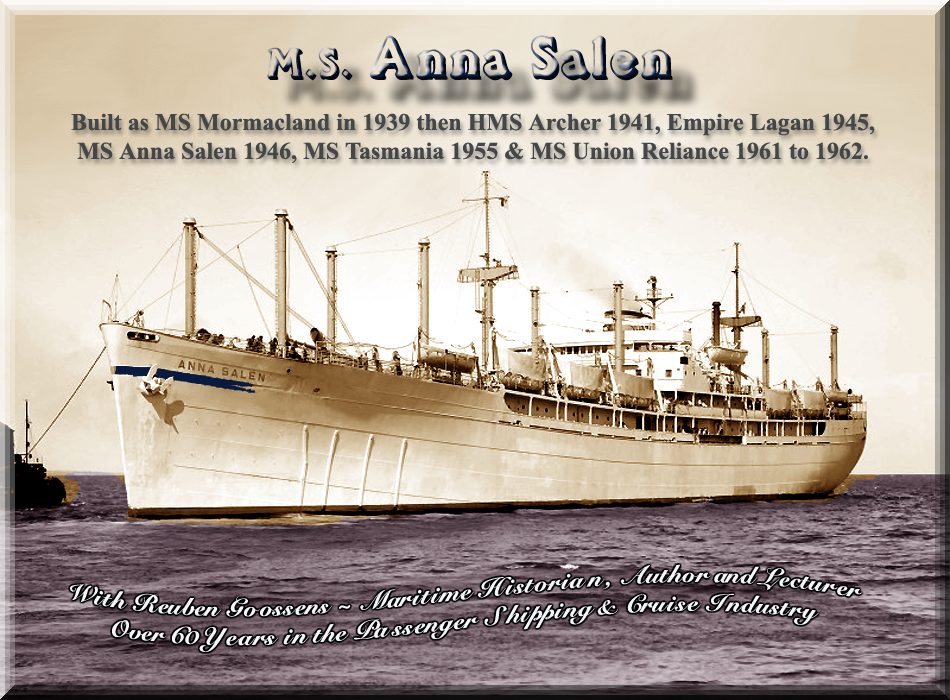
M.S. Empire Lagan &
BAVG-1 again
Introduction:
Page One, will commence with the very
beginning of this ship the 12 passenger cargo liner the
M.S. Mormacland
The
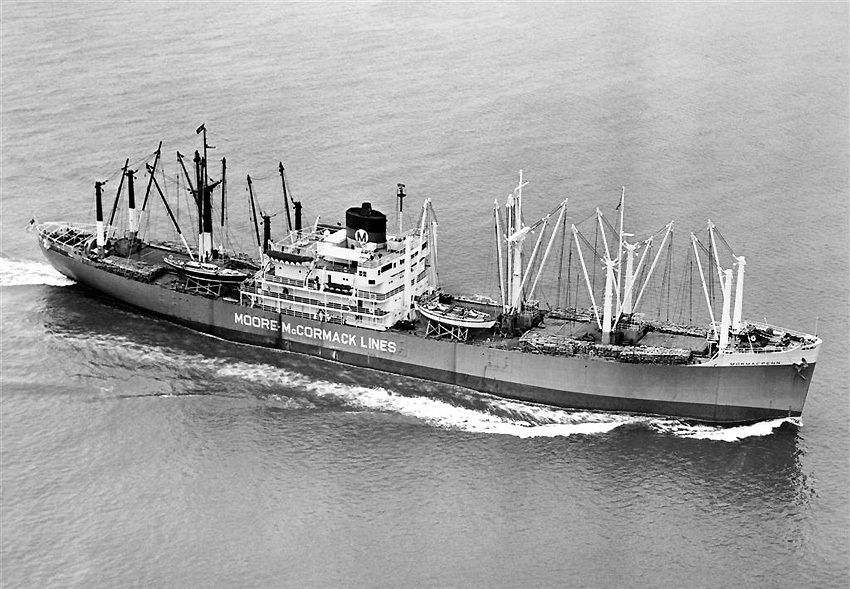
Each of these ships would have space for 10 or 12 passengers, and they
were powered by four Busch-Sulzer diesels connected to a single propeller shaft
through
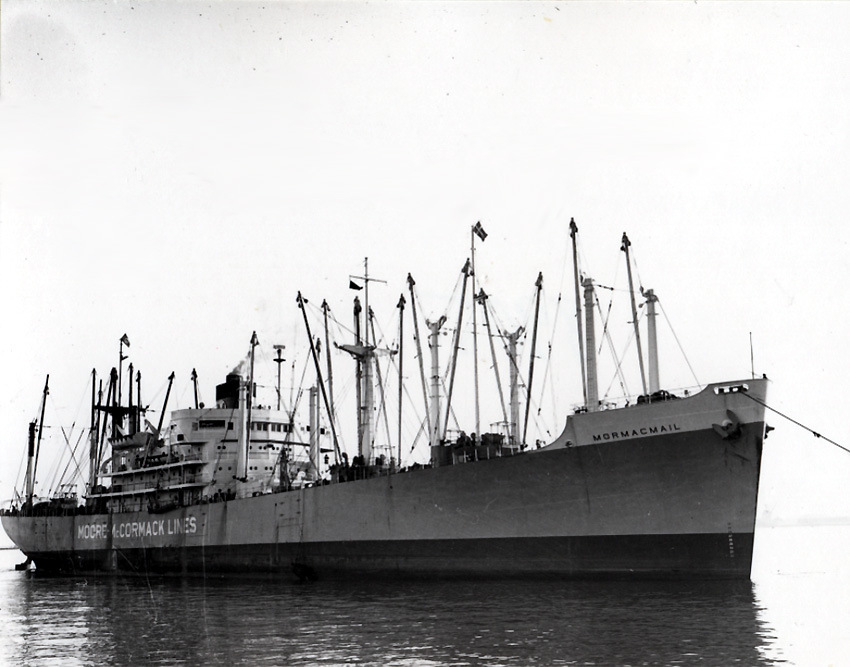
The Mormacland was launched on December 14,
1939, by her sponsor Miss. Anne E. Bailey, she was the
daughter of

The Mormacland was the third of the series built, and she would become famous
But that was when she was the HMS Archer’s as her Planes sunk the U-boat U-752
in the
with a U-Boat kill without the assistance from any of the warships
Her sister the M.S. Mormacmail, which became the became the USS Long Island and later was rebuilt into the very popular German passenger liner, M.S. Nelly, then after a further rebuild and wonderful interior refit, she was renamed the Seven Seas.
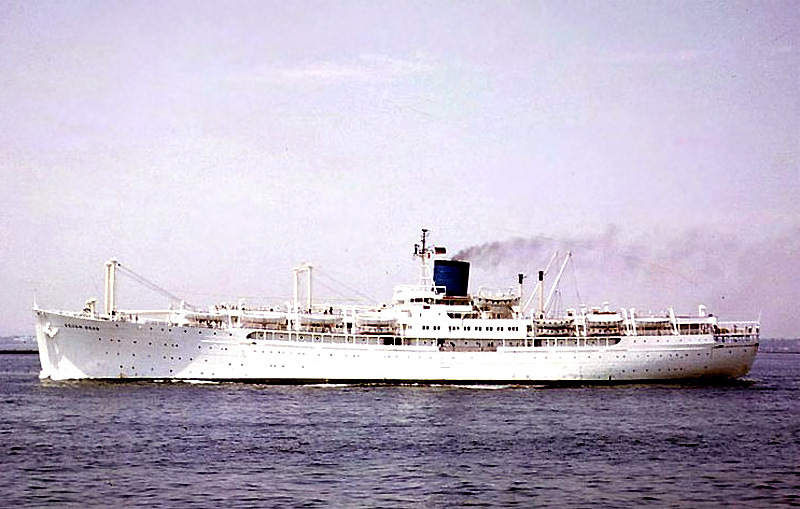
A LINK to her feature is located at the bottom of this page.
However we have to return to the ship of this
feature, being the
Conversion of BAVG-1:
The Mormacland, or as she was designated
BAVG-1, prior to her being renamed, was to be converted in the same manner as
her sister the Mormacmail. The conversion consisted of installing a lightweight
flat wooden flight deck on a metal truss superstructure that covered 70% of the
ship's length, with a hangar below the flight deck, which was serviced by a
single lift located aft. She did not have a traditional aircraft carrier Island
Superstructure, for there was a small
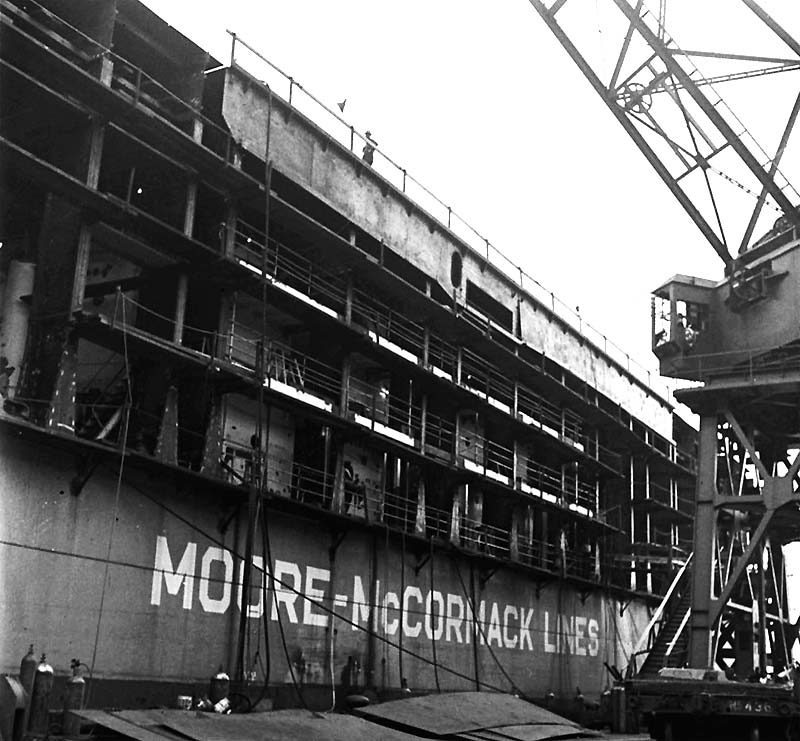
BAVG-1 is seen under construction
Above: We see her original hull with the “Moore-McCormack Lines” markings
Below: We see her bow and her forward an upper superstructure under construction
Sourced
from “
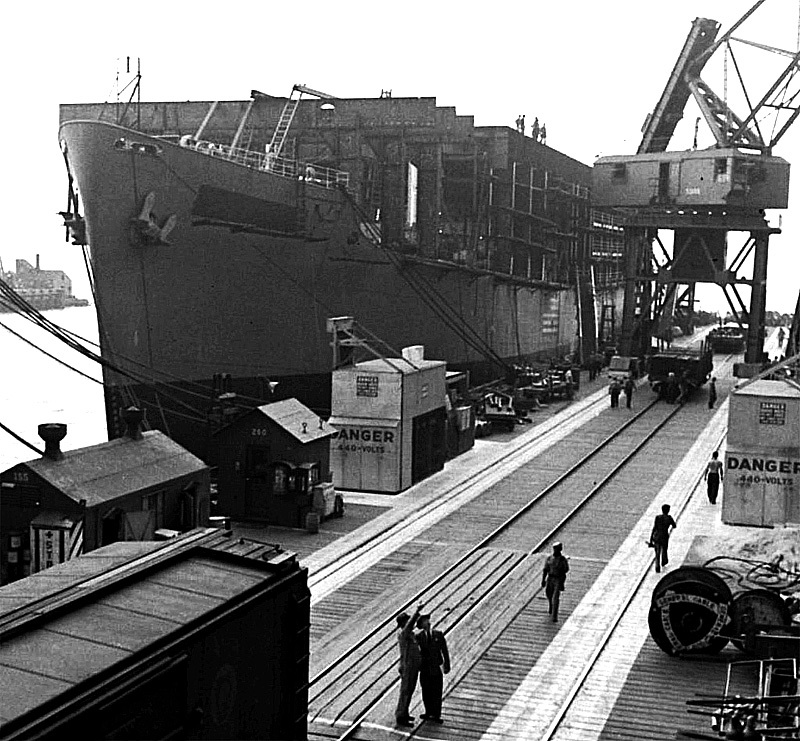
BAVG-1 is seen under construction
Sourced
from “
Obviously her original funnel had to be removed and it was replaced by a system that split the exhausts into two deck level vents which emerged amidships on either side of the flight deck. Although this concealed the funnel and reduced her silhouette, it did cause some problems for when she was steaming at maximum speed, being necessary for flight operations, her diesel engines tended to produce volumes of black smoke that at times could completely obscure the visibility of flight deck, if fact, so much so that pilots could see neither the batsman and at times not even the part of the deck where they had to land.
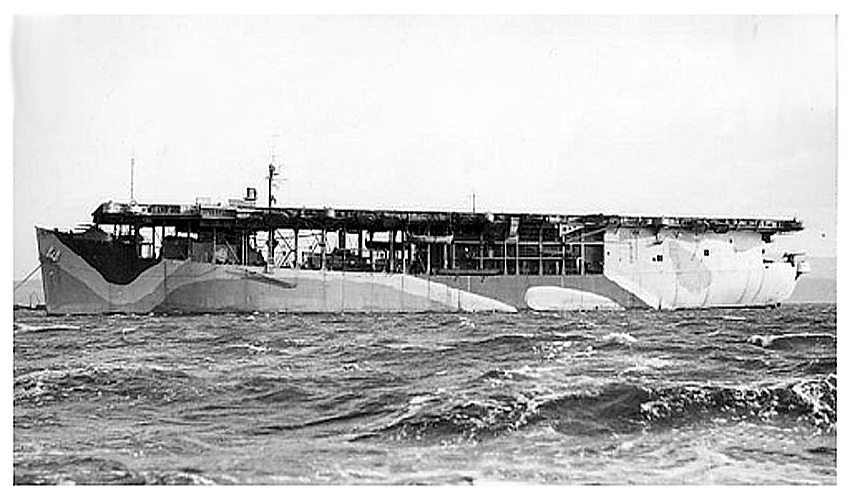
An early postcard released of the HMS Archer with no aircraft of her flight deck
Her conversion was completed on November 15,
1941 and she was officially transferred and commissioned on November 17, 1941
by the Royal Navy as HMS Archer (D78) at
But then during her first trial, it was discovered that her Busch-Sulzer diesel engines had some real problems, but somehow she managed to carry on, but only with the very best mechanics always having to be at the ready to fix the ongoing problems.
Having been fully manned and completely stored, HMS Archer commenced her most important trials in Hampton Roads on Sunday December 23, 1941; that is after the aforementioned ship handling runs and other trials, but now three US Navy Wildcats (aircraft) would have to be out on deck and see if everything is working, such as the ships “landing” and “accelerator” trials, the first Wildcat landed safely aboard at 11:06 a.m. But, sadly tragedy was to strike on the first catapult launch off the ship; half an hour later, for the “hydraulic aircraft accelerator” misfired, causing the fighter plane to be released prematurely and without enough airspeed the Wildcat fell into the sea off the bow. An fine crew member, dove over the side and made repeated attempts to locate and rescue the pilot, but sadly he was sadly unable to locate him, thus this brave RAF fighter and the aircraft was lost.
Later the remaining two Martlets aircraft were
flown off the deck while steaming at full speed into the wind as the
accelerator was damaged beyond repair. HMS Archer put into Philadelphia Navy
Yard on Christmas Eve for repairs, but she was not ready to continue her trials
until after the New Year. It was on January 2, 1942,
the
Off on duties, but disaster strikes in January 1942:
A week later on January 9,
HMS Archer left Norfolk on the morning of the 13th bound for Kingston, Jamaica where she was to embark her own aircraft, four Swordfish belonging to 834 Naval Air Squadron from RNAS Palisadoes.
But once again, she would quickly suffer
further mechanical failures; first her steering broke down at 10:30, followed
by the gyrocompass which failed again at 1140. After making repairs she resumed
her course for
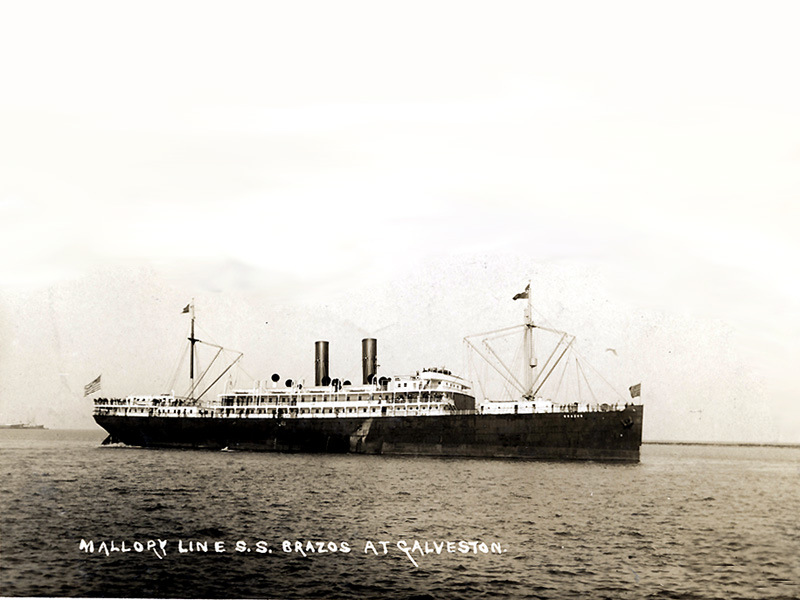
A postcard of the ill-fated Mallory Line, SS Brazos
The US Coast Guard tug “
Then on January 28, the
With repairs to her bow now finally completed,
HMS Archer departed for duties once again on March 18, 1942, and she was now
officially based in
Finally having completed a voyage from Cape Town to New York, where she arrived on July 15, 1942, and it would there where she would be given a complete machinery overhaul, and all her mechanical problems would finally be fixed, so much so she remained in good running order until much later when further severe mechanical problems occurred after she had become a passenger ship, whilst on the Indian Ocean and all her 1,500 plus passengers were transferred in Aden to another ship, but more on that story on page two.
HMS Archer's service history includes Atlantic
convoy escort from February to November 1942. During November 1942, she ferried
30 P-40 War-hawks from
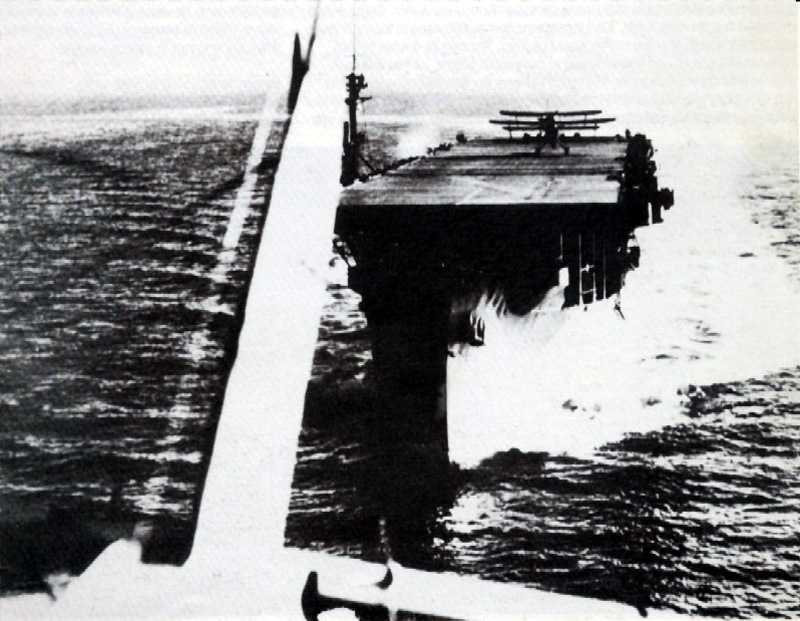
Here
we see a photo taken from an aircraft having just taken off from the
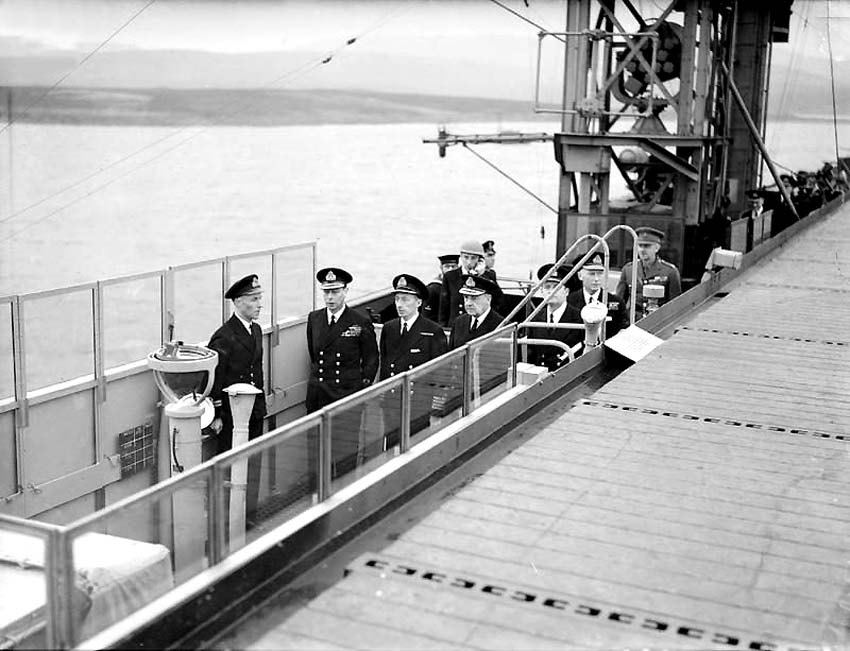
HRH King George VI is seen on the portside Bridge Wing and on his left is the captain of HMS Archer, and the
Admiral Commanding all Aircraft Carriers, Vice Admiral, Sir.
And it was on May 23, 1943 that one of her
aircraft, a swordfish from the 819 squadron fired rockets into a German U-Boat U-752 in the
Sadly HMS Archer was again plagued by engine
and machinery defects, and further work had to be undertaken on major engine
repairs in August, 1943. It was found that her defects were so extensive and
the Admiralty decided to withdraw her from active duty status effective from
November 6, 1943. Three days later Commander,
The
M.S. Empire Lagan:
This major period of maintenance and
conversion work was to take seven and a half months to complete, and was
finished on March 15, 1945. During the period in the hands of the dockyard it
had become clear that
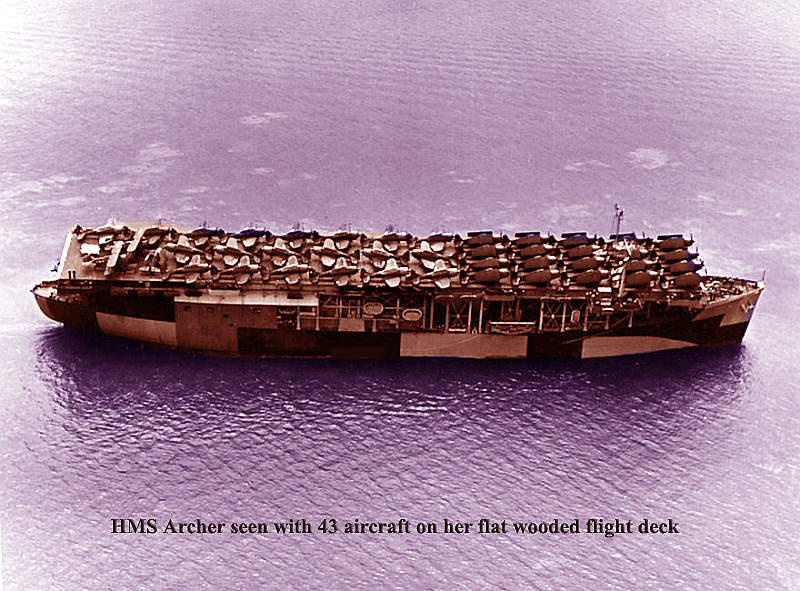
The
HMS Archer was officially decommissioned on
March 15, 1945 and she was renamed the “Empire Lagan”, although she
was not rebuilt and she looked the same as did during the war, even her
defensive armament remained it had been during the war. The only change was
that she was now no longer had the full camouflage paintwork, and was just
painted a dull grey. During her time with “MoWT”
she was managed (amazingly) by the “Blue Funnel Line” and was
registered in
Little is known of Empire Lagan’s
career, except that she made an Atlantic crossing with the west bound in Convoy
UC-69, which departed Liverpool on May 24, 1945 and
she arrived in
“The
“Converted Carrier Due at
“A merchant ship converted as an
auxiliary aircraft carrier, the Empire Lagan, is due to arrive at
The vessel is one of a number of similar ships
operated by the commercial owners for the British Government, and is the first
aircraft-carrying vessel to visit the Dominion. She is to berth at the
On September 8, the “NZ Herald”
published the following (not a great quality) photograph;
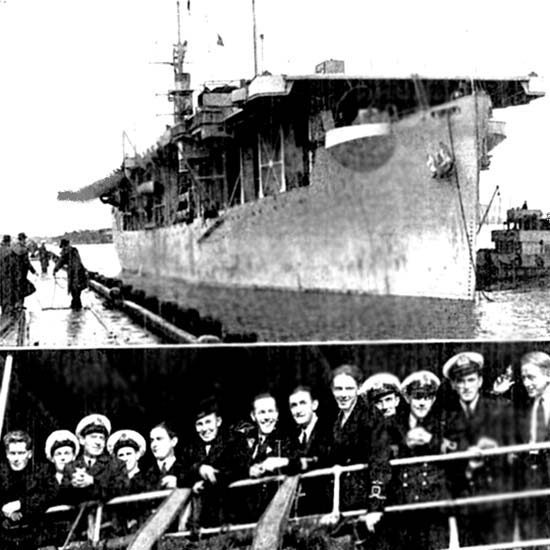
Upper:
The auxiliary aircraft-carrier Empire Lagan, which arrived at
Lower: Some of the R.N.Z.N.V.R. (A) personnel who returned in the ship
The NZ Herald wrote on September 8:
“The first “flat-topped”
ship to visit
The main reason for the Empire Lagan’s
visit to
While she was berthed at the Western Wharf in Auckland, it had been decided that on Saturday the 8th she would be opened to the public, and it was expected that no more than up to five hundred would turn up, but amazingly the ship was overwhelmed with almost 20.000 people heading for the wharf and whishing to visit the merchant aircraft transport ship on that day. Crowds swarmed all over and through her.
The M.S.? Empire Lagan departed and
headed for
HMS Archer
& M.S. Empire Lagan (BAVG-I) Final Days:
BAVG-1 (formerly
BAVG-1 was officially returned to the US Navy at Norfolk, Virginia on January 9, 1946, and she decommissioned was stricken for “disposal” on February 26, 1946 and laid-up on the James River to awaiting to be sold.
Specifications & Details
Built by:?????????????????????????????????????????? Sun
Shipbuilding & Drydock Co.,
Yard:?????????????????????????????????????????????? 184.
Launched:???????????????????????????????????????? December 14, 1939 as the Mormacland.
Tonnages:??????????????????????????????????????? 7,886 GRT - Mormacland 1939.
.????????????????????????????????????????????????????? 7,886 GRT - BVGI 1941.
.????????????????????????????????????????????????????? 13,399 GRT -
.????????????????????????????????????????????????????? 13,399 GRT - Empire Lagan 1941.
.????????????????????????????????????????????????????? 11,762 GRT -
.????????????????????????????????????????????????????? 7,368
GRT -
Length:??????????????????????????????????????????? 494 ft - 150.5 m.
Beam:????????????????????????????????????????????? 69.2 ft - 21.1 m.
Draught:?????????????????????????????????????????? 29.1 ft - 8.86 m.
Propulsion:?????????????????????????????????????? 4 × 7 cylinder SCSA diesel engines (Busch-Sulzer Bros Diesel Engine Co, St Louis) 2,060 HP (1,540 kW) each, driving a large single screw through electro-magnetic couplings and single reduction gearing.
Speed:???????????????????????????????????????????? Service speed 15.5 knots, maximum 17.5 knots.
Range:???????????????????????????????????????????? 14,550 nautical miles (26,950 km) at 10 knots.
Passengers:????????????????????????????????????? 1,500
aboard the
HMS
Complement:??????????????????????????????????? 555.
Armament:??????????????????????????????????????? 3 × 4 in (102 mm) guns, 4 × twin and 7 × single machine guns, 7 × 20 mm guns AA guns, 4 twin 20 mm AA guns.
Armour:?????????????????????????????????????????? None.
Aircraft carried:???????????????????????????????? 15.
Aviation facilities:????????????????????????????? 1 lift, 1 catapult, 9 arrester wires and 3 barriers.
Ports of Registration:
1945:??????????????????????????????????????????????
1946:??????????????????????????????????????????????
1948:??????????????????????????????????????????????
1955:??????????????????????????????????????????????
1961:??????????????????????????????????????????????
Fate:?????????????????????????????????????????????? Scrapped
in
INDEX:
Page One …?????????? History of
Page Two … ????????? History of
the
Page Three …??????? 1.
.??????????????????????????? 2. Union Reliance, a pdf “Coast Guard inquiry” who was to blame of the collision between her and the M/V Berean.
***********************************
I watched them come, I watched them go and I watched them die.”
Return to the ssMaritime MAIN INDEX
ssMaritime.com &
ssMaritime.net
Please Note: ssmaritime and associated sites are 100% non-commercial and the
author seeks no funding or favours of any shape or
form, never have and never will!
Photographs on ssmaritime and associate
pages are: by the author or from the
author’s private collection. In addition there are some images that have
been provided by Shipping Companies and private photographers or collectors.
Credit is given to all contributors. However, there are some photographs
provided to me without details regarding the photographer/owner concerned. I
hereby invite if owners of these images would be so kind to make them-selves
known to me (my email address may be found on www.ssmaritime.com only), in order that due credit may be given.
This notice covers all pages: although, and I have done my best to ensure that all photographs are
duly credited and that this notice is displaced on each page, that is, when a
page is updated!
ssMaritime is owned & ? Copyright
by
